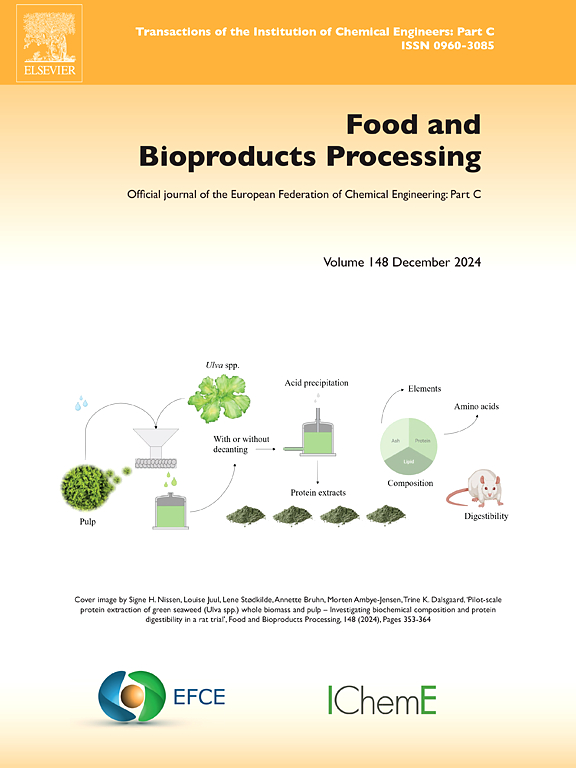用蛋白分离物包被蔓越莓多酚成分的微胶囊化:多酚类化合物生物利用度的体外评价
IF 3.4
2区 农林科学
Q2 BIOTECHNOLOGY & APPLIED MICROBIOLOGY
引用次数: 0
摘要
本研究的目的是评价不同蛋白类型对蔓越莓多酚内核微胶囊中多酚类化合物体外含量和生物利用度的影响。通过评估与正常结肠上皮细胞的生物相容性,研究了载体对微胶囊的理化性质、胃肠道特定部位的肿胀能力以及使用安全性的影响。采用海藻酸盐(AL)和AL与乳清分离蛋白(WPI)、豌豆分离蛋白(PPI)、大豆分离蛋白(SPI)、南瓜分离蛋白(PNPI)、向日葵分离蛋白(SNPI)和大米分离蛋白(RPI)等7种基质进行离子化凝胶法制备微胶囊。结果表明,所有微胶囊在干重、直径、吸湿性、颜色和生物相容性方面均具有可比性和令人满意的性能。然而,蛋白质的选择显著影响其他参数的值。SPI微胶囊的工艺效率最高,SNPI和PNPI微胶囊的多酚含量和抗氧化活性均较高。相比之下,估计含有WPI的微胶囊的生物利用度最高。这些发现可能对食品、营养药品和制药工业的新配方和产品的设计具有重要意义。本文章由计算机程序翻译,如有差异,请以英文原文为准。
Microencapsulation of the polyphenolic fraction of cranberry fruit (Vaccinium oxycoccos) with coatings based on protein isolates: in vitro assessment of the bioavailability of polyphenolic compounds
The aim of this study was to evaluate the effect of the type of protein used on the in vitro content and bioavailability of polyphenolic compounds from microcapsules with a cranberry polyphenolic core (CF). The effect of the carriers on the physicochemical properties of the microcapsules, swelling capacity in specific sections of the gastrointestinal tract, and safety of use was also examined by assessing biocompatibility with normal colonic epithelial cells. The microcapsules were prepared by ionotropic gelation using seven matrices: alginate (AL) and AL with whey protein isolate (WPI), pea protein isolate (PPI), soybean protein isolate (SPI), pumpkin protein isolate (PNPI), sunflower protein isolate (SNPI), and rice protein isolate (RPI). According to the results, all microcapsules demonstrated comparable and satisfactory properties in terms of dry weight, diameter, hygroscopicity, color, and biocompatibility. However, the choice of protein significantly influenced the values of other parameters. Microcapsules based on SPI provided the best process efficiency, while higher polyphenol content and antioxidant activity were observed for microcapsules containing SNPI and PNPI. In contrast, the highest bioavailability was estimated for microcapsules containing WPI. These findings could have significant implications for the design of new formulations and products for the food, nutraceutical, and pharmaceutical industries.
求助全文
通过发布文献求助,成功后即可免费获取论文全文。
去求助
来源期刊

Food and Bioproducts Processing
工程技术-工程:化工
CiteScore
9.70
自引率
4.30%
发文量
115
审稿时长
24 days
期刊介绍:
Official Journal of the European Federation of Chemical Engineering:
Part C
FBP aims to be the principal international journal for publication of high quality, original papers in the branches of engineering and science dedicated to the safe processing of biological products. It is the only journal to exploit the synergy between biotechnology, bioprocessing and food engineering.
Papers showing how research results can be used in engineering design, and accounts of experimental or theoretical research work bringing new perspectives to established principles, highlighting unsolved problems or indicating directions for future research, are particularly welcome. Contributions that deal with new developments in equipment or processes and that can be given quantitative expression are encouraged. The journal is especially interested in papers that extend the boundaries of food and bioproducts processing.
The journal has a strong emphasis on the interface between engineering and food or bioproducts. Papers that are not likely to be published are those:
• Primarily concerned with food formulation
• That use experimental design techniques to obtain response surfaces but gain little insight from them
• That are empirical and ignore established mechanistic models, e.g., empirical drying curves
• That are primarily concerned about sensory evaluation and colour
• Concern the extraction, encapsulation and/or antioxidant activity of a specific biological material without providing insight that could be applied to a similar but different material,
• Containing only chemical analyses of biological materials.
 求助内容:
求助内容: 应助结果提醒方式:
应助结果提醒方式:


